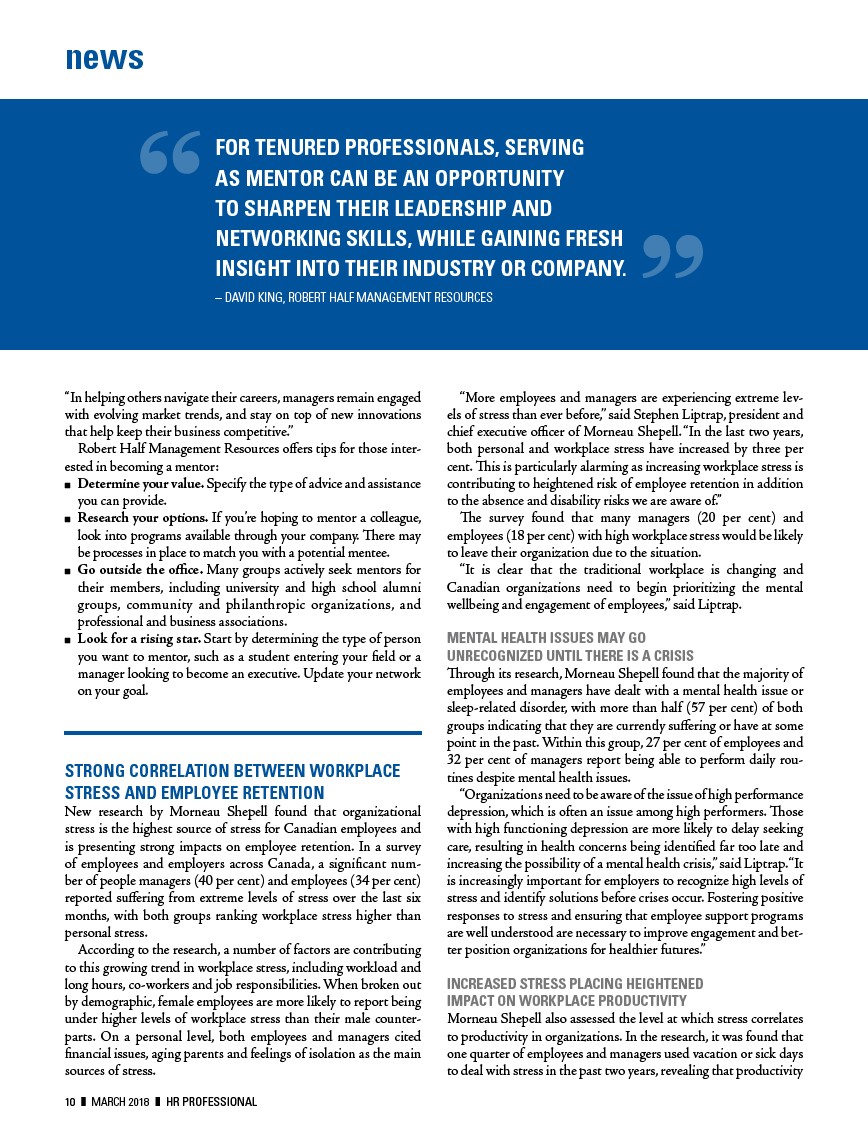
news
FOR TENURED PROFESSIONALS, SERVING
AS MENTOR CAN BE AN OPPORTUNITY
TO SHARPEN THEIR LEADERSHIP AND
NETWORKING SKILLS, WHILE GAINING FRESH
INSIGHT INTO THEIR INDUSTRY OR COMPANY.
– DAVID KING, ROBERT HALF MANAGEMENT RESOURCES
“In helping others navigate their careers, managers remain engaged
with evolving market trends, and stay on top of new innovations
that help keep their business competitive.”
Robert Half Management Resources offers tips for those inter-ested
in becoming a mentor:
■■ Determine your value. Specify the type of advice and assistance
you can provide.
■■ Research your options. If you’re hoping to mentor a colleague,
look into programs available through your company. There may
be processes in place to match you with a potential mentee.
■■ Go outside the office. Many groups actively seek mentors for
their members, including university and high school alumni
groups, community and philanthropic organizations, and
professional and business associations.
■■ Look for a rising star. Start by determining the type of person
you want to mentor, such as a student entering your field or a
manager looking to become an executive. Update your network
on your goal.
STRONG CORRELATION BETWEEN WORKPLACE
STRESS AND EMPLOYEE RETENTION
New research by Morneau Shepell found that organizational
stress is the highest source of stress for Canadian employees and
is presenting strong impacts on employee retention. In a survey
of employees and employers across Canada, a significant num-ber
of people managers (40 per cent) and employees (34 per cent)
reported suffering from extreme levels of stress over the last six
months, with both groups ranking workplace stress higher than
personal stress.
According to the research, a number of factors are contributing
to this growing trend in workplace stress, including workload and
long hours, co-workers and job responsibilities. When broken out
by demographic, female employees are more likely to report being
under higher levels of workplace stress than their male counter-parts.
On a personal level, both employees and managers cited
financial issues, aging parents and feelings of isolation as the main
sources of stress.
“More employees and managers are experiencing extreme lev-els
of stress than ever before,” said Stephen Liptrap, president and
chief executive officer of Morneau Shepell. “In the last two years,
both personal and workplace stress have increased by three per
cent. This is particularly alarming as increasing workplace stress is
contributing to heightened risk of employee retention in addition
to the absence and disability risks we are aware of.”
The survey found that many managers (20 per cent) and
employees (18 per cent) with high workplace stress would be likely
to leave their organization due to the situation.
“It is clear that the traditional workplace is changing and
Canadian organizations need to begin prioritizing the mental
wellbeing and engagement of employees,” said Liptrap.
MENTAL HEALTH ISSUES MAY GO
UNRECOGNIZED UNTIL THERE IS A CRISIS
Through its research, Morneau Shepell found that the majority of
employees and managers have dealt with a mental health issue or
sleep-related disorder, with more than half (57 per cent) of both
groups indicating that they are currently suffering or have at some
point in the past. Within this group, 27 per cent of employees and
32 per cent of managers report being able to perform daily rou-tines
despite mental health issues.
“Organizations need to be aware of the issue of high performance
depression, which is often an issue among high performers. Those
with high functioning depression are more likely to delay seeking
care, resulting in health concerns being identified far too late and
increasing the possibility of a mental health crisis,” said Liptrap. “It
is increasingly important for employers to recognize high levels of
stress and identify solutions before crises occur. Fostering positive
responses to stress and ensuring that employee support programs
are well understood are necessary to improve engagement and bet-ter
position organizations for healthier futures.”
INCREASED STRESS PLACING HEIGHTENED
IMPACT ON WORKPLACE PRODUCTIVITY
Morneau Shepell also assessed the level at which stress correlates
to productivity in organizations. In the research, it was found that
one quarter of employees and managers used vacation or sick days
to deal with stress in the past two years, revealing that productivity
10 ❚ MARCH 2018 ❚ HR PROFESSIONAL